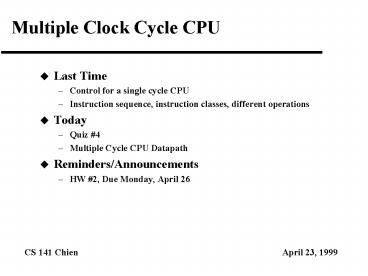Multiple Clock Cycle CPU - PowerPoint PPT Presentation
1 / 19
Title:
Multiple Clock Cycle CPU
Description:
We will use Register-Transfer-Language (RTL) to describe these steps ... target is a new state element (temp register) ... Required a few new state elements ... – PowerPoint PPT presentation
Number of Views:59
Avg rating:3.0/5.0
Title: Multiple Clock Cycle CPU
1
Multiple Clock Cycle CPU
- Last Time
- Control for a single cycle CPU
- Instruction sequence, instruction classes,
different operations - Today
- Quiz 4
- Multiple Cycle CPU Datapath
- Reminders/Announcements
- HW 2, Due Monday, April 26
2
Why a Multiple Clock Cycle CPU?
- the problem gt single-cycle cpu has a cycle time
long enough to complete the longest instruction
in the machine - the solution gt break up execution into smaller
tasks, each task taking a cycle, different
instructions requiring different numbers of
cycles or tasks - other advantages gt reuse of functional units
(e.g., alu, memory) - performance instructions cpi cycle time
3
High-level View
4
Multicycle datapath
5
Breaking Execution Into Clock Cycles
- Introduces extra registers when
- signal is computed in one clock cycle and used in
another, AND - the inputs to the functional block that outputs
this signal can change before the signal is
written into a state element. - Significantly complicates control. Why?
- The goal is to balance the amount of work done
each cycle.
6
Breaking Execution Into Clock Cycles
- We will have five execution steps (not all
instructions use all five) - fetch
- decode register fetch
- execute
- memory access
- write-back
- We will use Register-Transfer-Language (RTL) to
describe these steps
7
1. Fetch
- IR MemPC
- PC PC 4
- (may not be final value of PC)
8
2. Instruction Decode and Register Fetch
- A RegIR25-21
- B RegIR20-16
- ALUOut PC (sign-extend (IR15-0) ltlt 2)
- compute target before we know if it will be used
(may not be branch, branch may not be taken) - target is a new state element (temp register)
- everything up to this point must be
Instruction-independent, because we still havent
decoded the instruction. - everything Inst-dependent from here on.
9
3. Execution, memory address computation, or
branch completion
- Memory reference (load or store)
- ALUOut A sign-extend(IR15-0)
- R-type
- ALUout A op B
- Branch
- if (A B) PC ALUOut
- At this point, Branch is complete, and we start
over others require more cycles.
10
4. Memory access or R-type completion
- Memory reference
- load
- MDR MemALUout
- store
- MemALUout B
- R-type
- RegIR15-11 ALUout
- R-type is complete
11
5. Memory Write-Back
- RegIR20-16 memory-data
- memory instruction is complete
12
Summary of execution steps
13
Complete Multicycle Datapath
(notice logic for jump instruction now included)
14
Instruction Fetch
- IR MemoryPC
- PC PC 4
15
Instruction Decode and Reg Fetch
A RegisterIR25-21 B RegisterIR20-16 Ta
rget PC (sign-extend (IR15-0) ltlt 2)
16
3. Execution (R-type)
- ALUout A op B
17
4. R-type Completion
RegIR15-11 ALUout
18
3. Branch Completion
if (A B) PC Target
19
Multicycle CPU Datapath Summary
- Performance gain from allowing some instructions
to complete faster - ET instrs CPI cycle time
- Required a few new state elements
- Control over multiple cycles interleaved
instruction schedules































